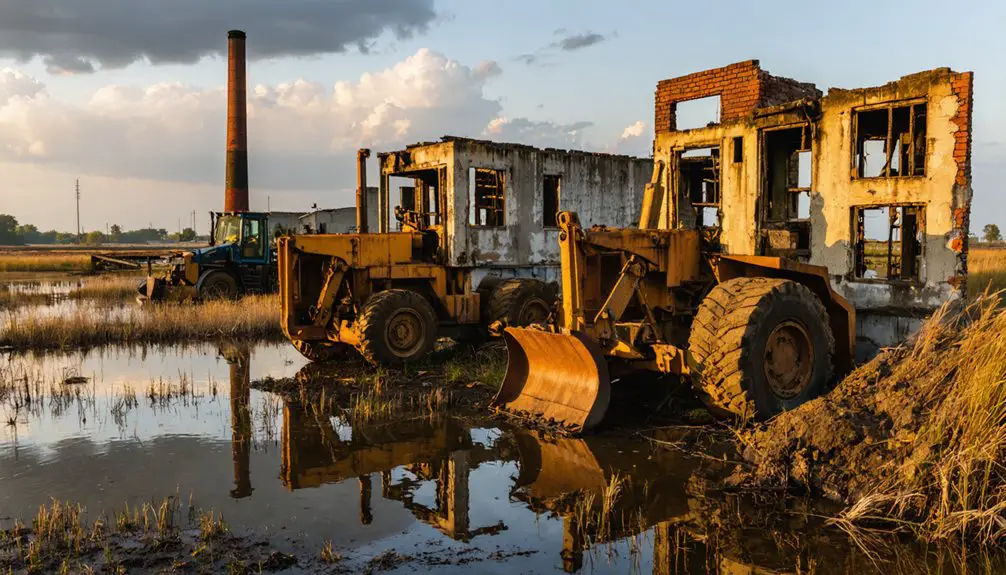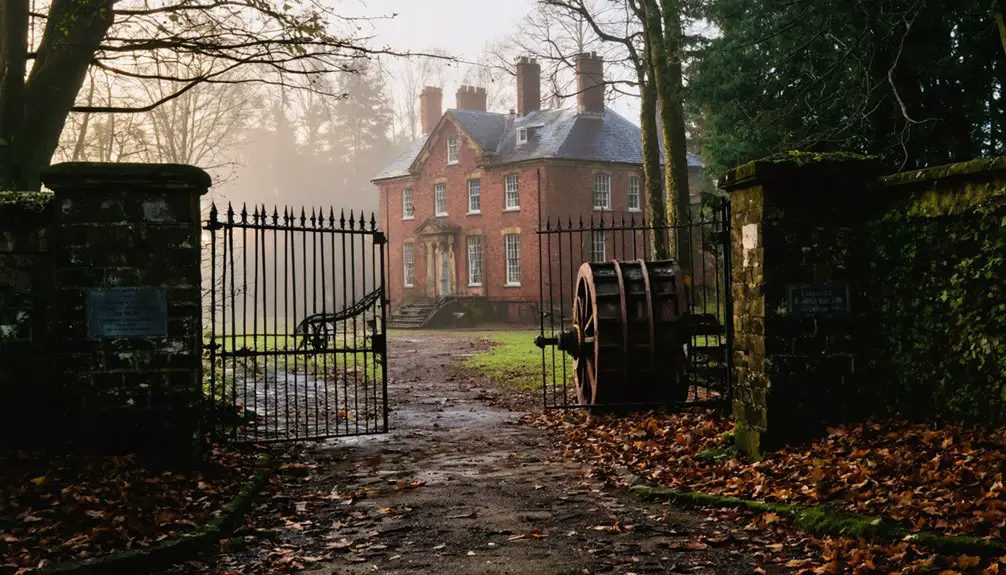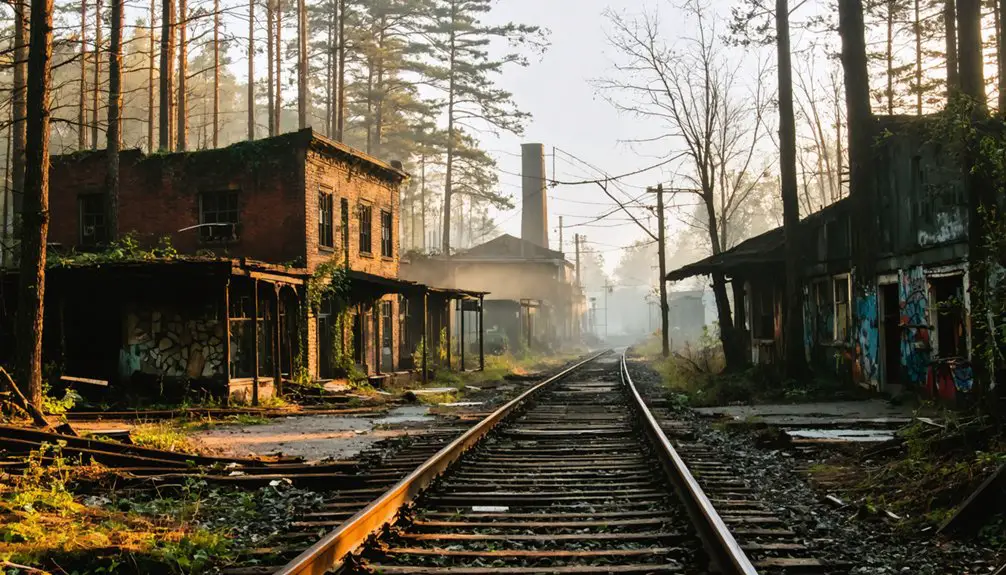You’ll find Port Elizabeth tucked away in New Jersey’s Pine Barrens, where this once-thriving port and industrial town now stands as a ghost of its former glory. Founded in 1785 by Elizabeth Clark Bodly, it flourished with glass works and iron furnaces along the Manumuskin River before declining in the mid-20th century. Today, you can explore its historic landmarks, including the Eagle Glass Works Hotel and colonial churches, while discovering the mysteries behind its dramatic transformation.
Key Takeaways
- Port Elizabeth transformed from a thriving industrial port town to a ghost town following economic decline in the mid-20th century.
- The town’s industrial legacy includes Eagle Glass Works (1799) and Cumberland Iron Furnace (1810), now abandoned historical sites.
- Port Elizabeth’s decline accelerated when maritime activity shifted to Port Newark-Elizabeth Marine Terminal in 1962.
- Historic landmarks and ruins showcase the town’s Quaker heritage and industrial past through walking tours and interpretive sites.
- The town’s ghost status draws tourists interested in Pine Barrens folklore and local legends like the Jersey Devil.
The Birth of a Port Town (1778-1798)
Three pivotal developments in 1778 marked Port Elizabeth’s transformation from a rural settlement into a thriving port town.
First, New Jersey’s Assembly legalized diking corporations, enabling critical land reclamation projects.
Second, a dam-bridge was built across the Manumuskin River, drying valuable meadows upstream for farming.
Third, wharves were constructed downstream to support commercial shipping.
Like nearby Salem County, the town saw significant port competition with Philadelphia and other major eastern cities.
The town’s destiny took shape through Elizabeth Clark Bodly’s strategic town planning in 1785.
After acquiring 213 acres from John Bell, this influential Quaker landowner laid out a practical grid system and began selling lots.
Her vision attracted merchants and shaped the port’s growth, culminating in federal recognition as a port of delivery in 1789.
The Methodist Episcopal Church received the first lot deed in 1785, establishing an early religious presence in the growing community.
You’ll find evidence of the town’s Quaker roots in its burial grounds and architecture.
Industrial Glory Days and Early Development
While Port Elizabeth’s early planning laid the groundwork for growth, the town’s industrial revolution began in earnest during the late 18th century.
You’ll find industrial innovations at the heart of this transformation, starting with Eagle Glass Works in 1799 and the Cumberland Iron Furnace in 1810. These industries thrived thanks to the strategic damming of the Manumuskin River, which powered their operations. Similar to glass manufacturing in Salem County that began with Caspar Wistar’s venture in 1738, this sector played a vital role in the region’s development.
The town’s community dynamics evolved rapidly as industrial growth attracted workers and sparked development. You can trace this expansion through projects like the construction of wharves, bridges, and diking systems that enhanced transportation and land use. Similar to Elizabeth, New Jersey’s position as a manufacturing center, Port Elizabeth attracted diverse workers who shaped its industrial landscape.
Port Elizabeth’s growth surged with industrialization, as workers flocked to new opportunities while infrastructure expanded to meet rising demands.
Notable developments included Manumuskin Manor, built before 1831, while the Quaker heritage influenced the town’s cultural growth alongside Methodist churches that served the expanding population.
Religious and Cultural Heritage
As Port Elizabeth took shape in the late 18th century, its religious landscape emerged through the pioneering efforts of Quaker founder Elizabeth Clark Bodly. In 1785, she donated land for a preaching house, burial ground, and schoolhouse, establishing the town’s spiritual foundation.
You’ll find remarkable religious diversity in Port Elizabeth’s history, from the 1786 Methodist Church to the Catholic congregation that formed between 1810 and 1845. These places of worship served as essential community centers, where faith intertwined with education and daily life. The Presbyterian influence was particularly strong, with three large congregations forming in Elizabethtown by 1853.
The Methodist Church, rebuilt in 1827 under Dr. Benjamin Fisler’s guidance, replaced the county’s first Methodist meeting house. The Spanish-speaking community would later flourish in New Jersey with Mass in Spanish first offered at Saint Patrick’s Church in 1923.
Perhaps most intriguing is the Catholic church’s journey – originally housed in the Port Elizabeth Academy, it was later moved by raft and wagon to Goshen in 1879.
The Decline of Port Elizabeth
Despite its early industrial prominence anchored by ventures like the Eagle Glass Works of 1799, Port Elizabeth experienced a dramatic decline throughout the mid-20th century.
The opening of the Port Newark-Elizabeth Marine Terminal and the shift toward containerized shipping in 1962 drew maritime activity away from the historic town. The area’s decline continued even as it became part of the Port Authority’s jurisdiction in 1921. You’ll find that this economic decline was compounded by inadequate rail infrastructure and the growth of competing facilities in New Jersey and Staten Island.
Port Elizabeth’s maritime decline accelerated as newer facilities and containerized shipping drew business to better-connected competing ports.
The town’s population loss accelerated as industries relocated or ceased operations entirely. The Singer Sewing Company, which had employed thousands, marked another industrial loss for the region.
While neighboring cities like Elizabeth adapted through diversification, Port Elizabeth couldn’t keep pace with changing global trade patterns. High labor costs, lack of investment, and the redistribution of regional economic functions to larger metropolitan areas ultimately transformed this once-bustling port town into a shadow of its former self.
Remaining Historical Landmarks
Port Elizabeth’s rich historical legacy lives on through its remarkable collection of preserved landmarks.
You’ll discover historic homes like Liberty Hall Museum, built in 1772 by New Jersey’s first governor, and the Belcher-Ogden Mansion, one of the state’s oldest residences. The 50-room Victorian Mansion within Liberty Hall offers a glimpse into 19th-century grandeur. Alexander Hamilton lived at Liberty Hall during his time in Elizabethtown while staying with the Livingstons.
Colonial churches stand as evidence to the area’s revolutionary spirit, including the First Presbyterian Church, rebuilt after the British raid of 1780. Its cemetery holds graves of early colonial figures. The historic Reverend James Caldwell served as the church’s pastor before his wife was killed by British forces.
You can explore these sites along the 3.5-mile Historic Walking Tour or Heartline Walking Tour, which feature over 40 locations. The Elizabeth River Trail follows ancient colonial pathways, connecting you to the town’s storied past.
Pine Barrens Ghost Town Legacy
Beyond Port Elizabeth’s preserved landmarks lies a haunting network of ghost towns scattered throughout New Jersey’s Pine Barrens.
You’ll find these abandoned settlements tell a compelling story of boom-and-bust cycles, where thriving industries like glassworks, iron furnaces, and paper mills once dominated the landscape before falling into decline by the late 1800s.
The ghost towns have become fertile ground for cultural storytelling, blending historical facts with local folklore.
These forgotten settlements weave together history and legend, creating a rich tapestry of stories passed down through generations.
While exploring these forgotten places, you’ll encounter tales of ghostly encounters, from the infamous Jersey Devil to Captain Kidd’s restless spirit.
These abandoned communities also served as essential sanctuaries for diverse groups seeking freedom, including Native Americans, escaped enslaved people, and religious refugees.
Today, nature has reclaimed many of these sites, leaving only whispered legends and crumbling foundations as evidence of their existence.
Environmental Impact and Geographic Significance
You’ll find that historical river dams around Port Elizabeth greatly altered local water flow patterns and aquatic ecosystems, contributing to the area’s environmental decline.
The systematic exploitation of natural resources, particularly through intensive logging and mining operations, led to widespread habitat destruction and soil degradation throughout the region.
These environmental pressures, combined with industrial pollution from port activities, have created lasting impacts on the local watershed and surrounding Pine Barrens ecosystem.
River Dam Effects
When the Manumuskin River was dammed in 1810, it created Cumberland Pond and sparked significant environmental changes that would shape the region’s ecology for centuries to come. The dam construction doubled the pond’s size, transforming the natural river flow into a still-water environment that altered the area’s ecological balance.
You’ll find the dam’s impact extends beyond just water management. It’s created distinct habitats that now support rare and endangered species like the barred owl, bald eagle, and pine barrens tree frog.
While the dam disrupted natural fish migration and sediment transport, it’s also formed unique wetland environments where sensitive species like the joint vetch thrive. The structure continues to influence local groundwater recharge and floodplain hydrology, making it an essential feature in the Pinelands ecosystem.
Natural Resource Depletion
The environmental toll on Port Elizabeth’s natural resources stands as a stark indication to decades of unchecked industrial development.
You’ll find a disturbing pattern of natural resource depletion across the region’s urban ecosystem, where wetlands have shrunk from 42 to just 13 square miles. The area’s transformation hasn’t just changed water composition – it’s fundamentally altered the landscape from freshwater to brackish environments.
You’re witnessing the results of aggressive industrial expansion: contaminated soil from hazardous waste sites, polluted air from port operations and refineries, and decimated wetland habitats.
The Hackensack and Newark Meadowlands exemplify this degradation, where three centuries of development have fragmented essential ecosystems. These changes have crippled natural water filtration systems and destroyed critical wildlife habitats, permanently reshaping Port Elizabeth’s environmental heritage.
Preservation Efforts and Modern Tourism
Modern preservation efforts in Port Elizabeth focus primarily on protecting key historical structures like the Eagle Glass Works Hotel from 1807 and the United Methodist Church established in 1827.
You’ll find preservation challenges in maintaining these landmarks, as coastal erosion and limited funding restrict large-scale restoration projects.
Tourism strategies integrate Port Elizabeth into broader Pine Barrens ghost town tours, where you can explore early American industrial and maritime history.
Through interpretive signage and local museums, you’ll discover the town’s Quaker heritage and industrial past.
While paranormal tourism isn’t as prominent here as in other New Jersey haunted sites, seasonal events and guided hikes blend ghost stories with cultural experiences.
You can join educational tours that combine visits to historical sites with nature exploration in the Maurice River area.
Frequently Asked Questions
Are There Any Documented Ghost Sightings in Port Elizabeth’s Abandoned Buildings?
While NJ records over 200 haunted locations statewide, you won’t find documented ghostly encounters or spectral apparitions in Port Elizabeth’s abandoned buildings, though nearby towns like Elizabeth and Cape May report frequent paranormal activity.
What Happened to the Original Residents When Industries Began Shutting Down?
You’ll find that economic decline forced residents to scatter, with many relocating to find new jobs elsewhere. The community displacement led families to seek opportunities in larger cities or nearby towns.
Can Visitors Legally Explore the Remaining Ruins in Port Elizabeth?
You’ll find legal exploration generally permitted at the ruins within the Manumuskin River Preserve, but you must follow visitor regulations, stay on public land, and respect any posted access restrictions.
Which Specific Industries Employed the Most Workers During Peak Operations?
Like a magnet drawing workers, the iron industry employed the most people, particularly at Batsto Iron Works. You’ll find glass manufacturing was the second-largest employer, overshadowing fishing industries and lumber production.
Does Anyone Still Live Within Port Elizabeth’s Original Township Boundaries?
You’ll find about 290 current residents living within the area’s original boundaries. While its historical significance has diminished, the community maintains an active population density of roughly 194 people per square mile.
References
- https://jerseydigs.com/new-jersey-haunted-houses/
- https://rsftripreporter.net/gone-goner-ghost-towns-new-jersey-pine-barrens-part/
- https://www.mauricerivertwp.org/2169/History
- https://southjerseytrails.org/2017/03/16/six-pine-barrens-ghost-towns-to-explore/
- https://www.onlyinyourstate.com/experiences/new-jersey/the-haunted-pine-barrens-nj
- https://npshistory.com/publications/new-jersey/historic-themes-resources/chap2.htm
- https://njmilitiamuseum.org/wp-content/uploads/nj-military-history.pdf
- https://visithistoricalelizabethnj.org/timeline/
- https://en.wikipedia.org/wiki/Port_Elizabeth
- https://steinsworth.com/the-history-of-elizabeth-new-jersey/



